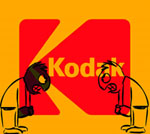Overcoming Business Blind Spots - Learning from the Demise of Kodak
 In the weeks following Kodak’s decision to file for bankruptcy, industry commentators and analysts have been busy conducting a post-mortem to figure out what contributed to its catastrophic downfall.
In the weeks following Kodak’s decision to file for bankruptcy, industry commentators and analysts have been busy conducting a post-mortem to figure out what contributed to its catastrophic downfall.
- Kodak enjoyed meteoric success in the 1960s and 1970s, with the release of the Instamatic camera series. From its heyday in the eighties there followed a slew of bad corporate decisions, paving the way for a slow, precipitous decline. It culminated in the bankruptcy hearing in New York last month, a depressing chapter in the company’s iconic history. It’s hard to believe this is the same pioneering company responsible for developing the first digital camera in 1975.
- Kodak’s demise has been attributed to a number of competitive failures and poor decisions rather than any one singular action. By failing to properly assess and respond to technological innovations, market changes, consumer attitudes and competitor advances, the once powerful photographic giant has been toppled from its perch.
- The unfortunate events at Kodak have served as a warning shot to corporate behemoths against taking their dominant market position for granted. In business there’s no room for complacency, especially at the top.
One of the purposes of Competitive Intelligence is to counteract this dangerous mindset of complacency by promoting in-depth understanding of a company’s market environment and competitive landscape. A strong, well-resourced Competitive Intelligence team will help militate against encroaching competitors and monitor early-warning signals such as changes to consumer sentiment, new trends and technological innovations. Competitive Intelligence is a business critical function for the 21st century, as companies must learn to innovate, adapt and respond to emerging threats at lightning speed in order to survive.
Below are three major areas that companies should focus on in order to overcome business blind spots and stay one step ahead of the competition.
Competitor Intelligence
A comprehensive competitor strategy takes account of direct and indirect competitors but also new entrants who pose a potential threat to your market share. Competitor Intelligence will provide you with answers to the following critical questions:
- What are my competitors’ strategies for development (i.e. acquisitions, expansion to new markets, new products, new targets, strategic alliances, etc.)?
- What are the most recent and relevant developments in my competitors organizational resources (i.e. financial, human, production capacity, technological, etc.)?
- How are my competitors developing their organizations and management teams?
- Where are their main areas of concern given their intelligence and research activities?
- Where and who are the potential entrants into our market?
Technology intelligence
Technologies are changing rapidly and are characterized by short life cycles. Companies need to monitor developments closely to ensure that their products continue to match current and foreseeable market demands. Anticipate and track technological developments and patenting activities that may affect current product development, manufacturing and other areas. Monitor information about new technologies and research activities with the potential to generate new applications for future products or to replace existing products.
Social Media Intelligence
The scale of information being produced and disseminated online every day is breathtaking. The unprecedented growth of Twitter and Facebook has transferred considerable power and influence to consumers and the associated reputational risks for businesses have to be managed carefully. Monitor what people are saying about your brand or products. If a false rumor or negative narrative is being spread it can be rebutted before it gains traction and wide circulation. With the right tools for effective sentiment analysis and social media monitoring, brand managers and market intelligence professionals can focus on promoting a favorable narrative about their brands, companies, and products. Track what is being said about your competitors online and detect buzz surrounding new product releases. This will help you to anticipate any changes to your competitors’ strategy.
Written by Jerome Maisch
Marketing Manager @digimindci. Passionate about big data & social marketing. Photography, music and hiking lover
